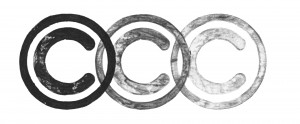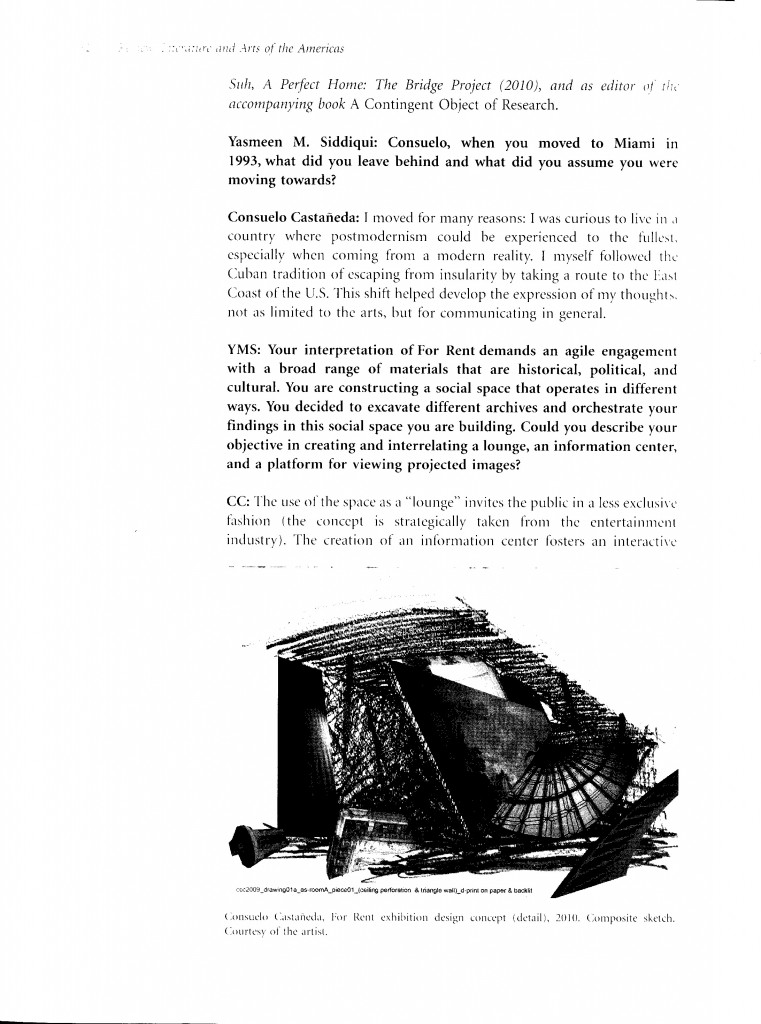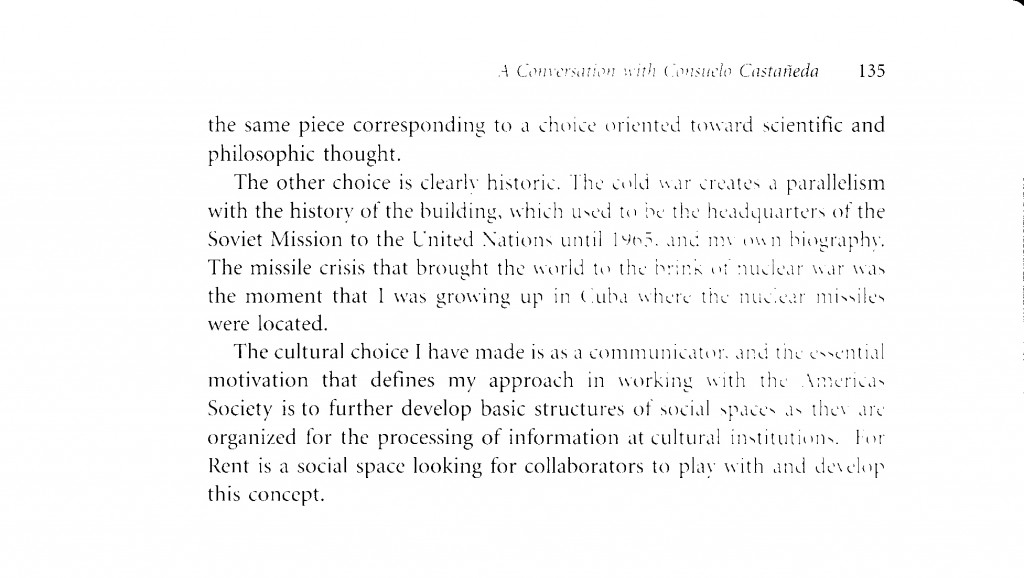A Conversation with Consuelo Castañeda
By Yasmeen M. Siddiqui
The exhibition For Rent: Consuelo Castañeda is an interactive visual system built up by three distinct yet interrelated environments, activating the generative possibilities of translating a broad spectrum of cultural, historical, and political facts, moments or quotations into a set of social settings for viewers both familiar and unfamiliar with the work of Castañeda, The Americas Society, and Cuba. This trans-historical, trans-disciplinary project opens in the spring of 2011.
Castañeda’s multi-dimensional, poetic, responsive interventions in the Americas Society gallery mark the first in a series of three annual artists’ projects that comprise For Rent. Gabriela Rangel, Americas Society Director of Visual Arts, has conceived this series. For this program, Castañeda assembles an anthology of Latin American art spanning the period from the Cold War to the emergence of globalization as related to the Americas Society’s exhibition history.
In response to this call Castañeda has devised a complex system of spaces, animating a seemingly incongruous set of documents. Her orchestration of the gallery rooms, and activation of regional and institutional histories and their archives, refuses a set of prescribed exhibition-making formats and techniques. Instead, she cultivates an unorthodox mode of communication that strategically posits different kinds of information, in contra-point, to elicit and disclose other and new institutional and art historical narratives.
Castañeda’s project is organized and “interpolated” by this interviewer.
Yasmeen M. Siddiqui: Consuelo, when you moved to Miami in 1993, what did you leave behind and what did you assume you were moving towards?
Consuelo Castañeda: Many reasons motivated my move: the curiosity of living in a country where postmodernism can be felt at its best, especially when coming from a modern reality. I myself followed the Cuban tradition to escape from insularity by taking a route to the East Coast of the US. This shift was to develop the expression of my thoughts, not as limited to the arts, but communication in general.
YMS: Your interpretation of For Rent demands an active and agile engagement with a broad range of materials that are historical, political, and cultural. You are constructing a social space that vacillates and operates in different ways. You have decided to excavate different archives and orchestrate your findings in this social space you are building. Could you describe your objective in creating and interrelating a lounge, an information center, and a platform for viewing projected images.
CC: This project is not an exhibition of my oeuvre in the space. It is a happening occurring in concert with the space, and the historical, political, and cultural elements of the institution. AS operates as content in the project. The presence of my oeuvre is justified only as a document within the exhibition.
The use of the space as a “lounge” invites the public in a less exclusive fashion (the concept is strategically taken from the entertainment industry). The creation of an information center fosters an interactive attitude on the part of the viewer in relation with “the archive” (the information is not restricted) and the screening is a resource to show ephemeral data.
YMS: The breadth of your practice is extremely rich and varied. The images you contemplate and engage, span time and place, encompassing a broad spectrum of references from both popular culture and the history of painting. You are able to work in two and three dimensions. You both make paintings and build environments. I would like to better understand how you feel and think the project For Rent will affect the way you have been approaching creating visceral, aesthetic environments.
CC: It is difficult to evade the artistic and aesthetic parameters, especially if you are operating in its system. However the AS among a lot of things is an information center and has the sensitivity to develop this aspect in the project. It is the network and the cybernetic way of processing information that most attracts me.
YMS: At the core of this project is a highly charged video montage. The themes are strong and combative, asserting a tone over the entire three-room exhibition. Could you elaborate on some of your choices, which films you are excerpting and how you are augmenting them. What are you driving at through your selection. What imprint and impact do you hope to achieve through your edits to a group of films that range from iconic to obscure.
CC: Cinematography is the leitmotif of the show, not only in the use of cinematographic material but also as inspirational element in the conception of the set. A scene from “The Trial” or “Le Procés” (1962) directed by Orson Wells, suggests the general visualization of the space. There is a scene that acts as a point of departure for me, where Romy Schneider is making love in a “holocaustic archive” and shows her lover the membrane that links the fingers of her hand as a physical condition that situates her as specimen in a stage “less evolved”. Also, the animation of Mount Fuji from Akira Kurosawa’s “Dreams“ (1990) has become a main detail, referring to worldwide nuclear annihilation and late modernism. The use of cinematography, whose origins date from 1895, is a testimony to the document and its contents in order to illustrate the transition from modernity to late modernity to post-modernity.
Issues such as industrialization, society as a “mass”, the process of rationalization, the development of optics, locomotion, alienation, identity, mutation, and information technology are included in the selected segments. Samples include: “Metropolis” by Fritz Lang, “THX 1138” by George Lucas, “Eraser Head” by David Lynch, “Avant Garde_1921”, “The Ossuary” and others tales by Jan Svankmajer, and “Stalker” by Andrei Tarkovski.
The edits are not linear and continuous; they are instantaneous. The segments are taken as is from the films, the music and the sound (not the spoken word) provides the narrative tension initially. Then, these segments of the movies articulated as vj sessions overlap each other, creating dissimilar palimpsēstus, not only between them, but also between them and the spaces on which they are projected. Digitized materials supplied by the spectator are incorporated (storage devices, p2p, cameras, iphone) and keyboard mappings are used as a synthesizer for musicians operating the visual data base at the time of execution of the music via midi.
YMS: Facsimiles of a wide variety are scattered throughout the gallery. There are copies of political and propagandistic posters; architectural details from the Americas Society building; and images from your oeuvres. There are also quotations taken from the AS’s exhibition history. You have made clear and considered choices in the moments and works you have decide to translate for this project. You reference the work of the Venezuelan modern artist Gego’s “Reticulárea”, which was shown in the same gallery. Her work proposed an alternate interpretation to the prevailing scope of kinetic sculpture through an insistence on the complete nature and existence of form, in this case the line as an autonomous, moving, spatial body. In For Rent, you pose this work as all but destroyed, with only some remnants hanging while the rest has fallen to the floor. It seems that for you nothing is disconnected, all forms and beings react and respond to their environment and those that inhabit it. Could you illuminate what you have decided to translate and remake Gego’s “Reticulárea”. Could you elaborate on the specific sources of inspiration that inform your approach to the AS gallery.
CC: Indeed, most of the documents in this “archive in ruin” are facsimiles since it is all simulacrum, including the work of Gego’s ” Reticulárea ” which I do not reproduce, but I quote. In Gego, I find reference for the reality I am experiencing, exploring with the space of the Americas Society Furthermore, I considered it appropriate to refer the crisis of structuralism in the 60’s. Paradoxically, regarding the rest of the exhibit, this quote of Gego’s work is intended to evoke the regenerative universe that the discovery and breakdown of the DNA structure opened unlike the insane degenerative use that nuclear physics made out of its own development.
Figures such as Fibonacci (1170-1250); Jamnitzer Wentzel (1508-1585), Johannes Kepler (1571-1630); Tatlin (1885-1953), Buckminster Fuller (1883-1895), Crick & Watson (DNA 1953) are articulated in the same piece that correspond to a choice oriented to the scientific and philosophic thought.
The other clear choice is historic. The “Cold War” creates a parallelism with the history of the building, which used to be head quarter for the Soviet Mission to the United Nations until 1965 and my own biography. The “crisis of the missiles” that brought the world to the brink of nuclear war was the moment that I was growing in Cuba where the nuclear missiles were established.
The cultural choice I have made is as communicator and the essential motivation that defines my approach with the AS is to further develop basic structures of social spaces as they are organized for the processing of information at cultural institutions. For Rent is a social space looking for collaborators to play with and develop this concept.






